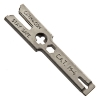That Ruger piston issue is exactly why the Garand had to be kept clean. Fail to bother and it would get stuck in the gas cylinder, requiring an armorer to repair it. So NCO's had to double down on regular cleaning as the remedy.
Tearing down the Garand gas cylinder mechanism isn't field easy. That left the soldier between a rock and a hard place - ignore it and it would jam in the gas cylinder, netting you the displeasure of the support chain and your supervisor, tear it down and you lost a half hour or more of your time and risked the loss of critical parts.
The M14 had to make changes in the gas cylinder to improve that, but the difference was incremental. It just got a little better.
On the other hand, DI fanboys know for a fact, under the clock, that a small child can tear down a M16 and reassemble it in literally seconds. Why do piston fanboys equate level of difficulty with superiority? The gas cylinder in the M16 is - again - almost too easy to get to. And the focus on getting it clean is misplaced - again - as ammo, magazines, and the operator are the top three causes of failure.
Don't mag dump a full combat load thru the weapon - which is contrary to doctrine, training, and lessons learned - the M16 works fine. It's not a squad auto machine gun, and the concept it can be abused in that role is where most users start having difficulties. It's one of the reasons the three shot trigger group was installed - to slow the rate of fire - along with the fact that the 3 round was likely rising off target and only had 50% effectiveness.
There is far more to using a firearm in combat than where the piston is located. DI haters love to focus on it being in the Bolt Carrier Group, but the reality is that for any modern design claimed to be superior, it's a clone of the M16 in almost every other significant feature. About the only advancement is the use of a polymer lower - the new age battle rifle owner is basically choosing to shoot what amounts to a Glock carbine but talking about the piston location as the difference. I will submit that it's smoke and mirrors on their part. The ARX, SCAR, and others are nice rifles, but they all use M16 control layouts, M16 magazines, and most importantly, use a barrel extension. Stoner's contribution in that regard has been unique and influenced civilian designs, too.
If anyone want's an "advanced" combat rifle, put the piston wherever you want. But I challenge you to refrain from using any other feature of the M16 to achieve a superior design. Good luck, as none of the newer guns being adopted seem to be able to do that.


